MILLET EXTENSION MANUAL
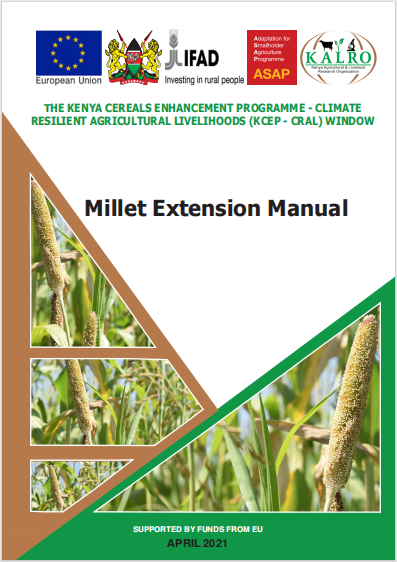 INTRODUCTION
Millets are a group of small seeded cereals grown in semi-arid dry areas. They include pearl
millet, finger millet, foxtail millet and prosso millet. They have a short growing season, can
withstand dry and high-temperature conditions and yet yield well, hence they are important
food security crops in semi-arid lands of Kenya. Millets are widely cultivated as human
food or as fodder for animals. The grains are similar in nutrient composition to maize but
richer in protein and fibre. They fit well in popular local recipes such as Ugali and Uji. In
addition to grain and forage/fodder uses, millet crop residues are used as building material
and fire wood for cooking, particularly in dry land areas. In recognition of millets nutrition
value and frequent maize crop failures, the Government of Kenya is putting more emphasis
on production of millet to mitigate food and nutritional security.
INTRODUCTION
Millets are a group of small seeded cereals grown in semi-arid dry areas. They include pearl
millet, finger millet, foxtail millet and prosso millet. They have a short growing season, can
withstand dry and high-temperature conditions and yet yield well, hence they are important
food security crops in semi-arid lands of Kenya. Millets are widely cultivated as human
food or as fodder for animals. The grains are similar in nutrient composition to maize but
richer in protein and fibre. They fit well in popular local recipes such as Ugali and Uji. In
addition to grain and forage/fodder uses, millet crop residues are used as building material
and fire wood for cooking, particularly in dry land areas. In recognition of millets nutrition
value and frequent maize crop failures, the Government of Kenya is putting more emphasis
on production of millet to mitigate food and nutritional security.
Continue reading
COMMON DRY BEAN EXTENSION MANUAL
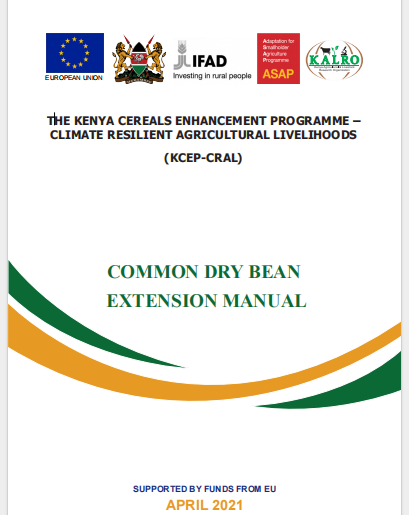 INTRODUCTION/ BACKGROUND
Pulses, or grain legumes in general, are an essential source of supplementary protein to daily
diets based on cereals and starchy for a predominantly vegetarian population and those who
cannot afford expensive animal protein. Pulses are therefore often regarded as “poor man’s
meat”. They provide energy, protein, essential minerals, vitamins and several compounds
considered beneficial for good health. Their cultivation enriches soil by adding nitrogen, and
improves the physical, chemical and biological soil properties. They are also well suited to
diverse environments and fit in various cropping systems owing to their wide adaptability,
low input requirements, fast growth, nitrogen fixing and weed smothering ability. Their
short growing period and photoperiod sensitivity make them suitable for crop intensification
and diversification. Notwithstanding their high production potential, their productivity is
generally low as these are cultivated on poor lands, with no or little inputs, and are susceptible
to several abiotic and biotic stresses.
INTRODUCTION/ BACKGROUND
Pulses, or grain legumes in general, are an essential source of supplementary protein to daily
diets based on cereals and starchy for a predominantly vegetarian population and those who
cannot afford expensive animal protein. Pulses are therefore often regarded as “poor man’s
meat”. They provide energy, protein, essential minerals, vitamins and several compounds
considered beneficial for good health. Their cultivation enriches soil by adding nitrogen, and
improves the physical, chemical and biological soil properties. They are also well suited to
diverse environments and fit in various cropping systems owing to their wide adaptability,
low input requirements, fast growth, nitrogen fixing and weed smothering ability. Their
short growing period and photoperiod sensitivity make them suitable for crop intensification
and diversification. Notwithstanding their high production potential, their productivity is
generally low as these are cultivated on poor lands, with no or little inputs, and are susceptible
to several abiotic and biotic stresses.
Continue reading
CLIMATE SMART EXTENSION MANUAL
 BACKGROUND INFORMATION
Climate change is real and has become an obstacle to achieving sustainable development
across the world. Climate change has both positive and negative effects in agriculture
depending on the regions of the world. The negative impacts are expected to be more serious
in the developing countries, particularly those in sub-Saharan Africa (SSA) such as Kenya.
For instance, Kenya has experienced increasing temperatures from 1960’s, together with
high frequency and intensity of extreme weather events such as El Niño and La Niña. The
effects of the negative impacts include declining agricultural productivity and loss of crops,
livestock, fish and investments in agriculture due to changing temperatures and rainfall and
many other extreme weather events.
BACKGROUND INFORMATION
Climate change is real and has become an obstacle to achieving sustainable development
across the world. Climate change has both positive and negative effects in agriculture
depending on the regions of the world. The negative impacts are expected to be more serious
in the developing countries, particularly those in sub-Saharan Africa (SSA) such as Kenya.
For instance, Kenya has experienced increasing temperatures from 1960’s, together with
high frequency and intensity of extreme weather events such as El Niño and La Niña. The
effects of the negative impacts include declining agricultural productivity and loss of crops,
livestock, fish and investments in agriculture due to changing temperatures and rainfall and
many other extreme weather events.
Continue reading
FARMERS' EXTENSION HANDBOOK CEREALS AND PULSES
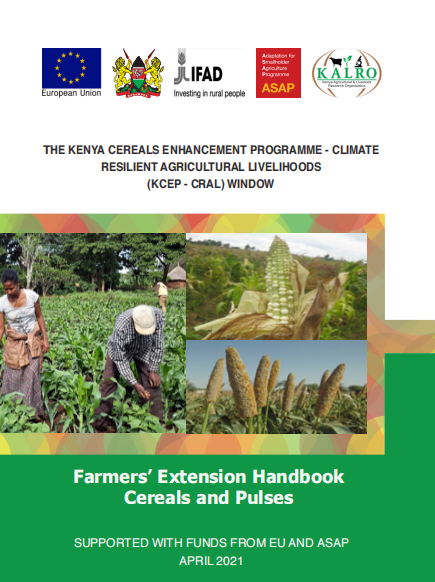 CLIMATE AND AGRICULTURE
The impact of climate change and variability on Kenya’s agricultural sector is of
great concern to policymakers, researchers, development partners, farmers and other
stakeholders. It is a big threat to achieving food security. This handbook presents
improved ways on adapting agricultural production systems to climate change
indicators, namely, increased temperatures, unpredictable rainfall, and extreme
climatic occurrences. The effects of climate change and variability are characterized
by increased frequency of droughts and floods, changes in weather patterns, high
rainfall intensity and increased incidence of pests and disease outbreaks. Below find
pictures of these effects on crop production systems.
CLIMATE AND AGRICULTURE
The impact of climate change and variability on Kenya’s agricultural sector is of
great concern to policymakers, researchers, development partners, farmers and other
stakeholders. It is a big threat to achieving food security. This handbook presents
improved ways on adapting agricultural production systems to climate change
indicators, namely, increased temperatures, unpredictable rainfall, and extreme
climatic occurrences. The effects of climate change and variability are characterized
by increased frequency of droughts and floods, changes in weather patterns, high
rainfall intensity and increased incidence of pests and disease outbreaks. Below find
pictures of these effects on crop production systems.
Continue reading
GREEN GRAM EXTENSION MANUAL
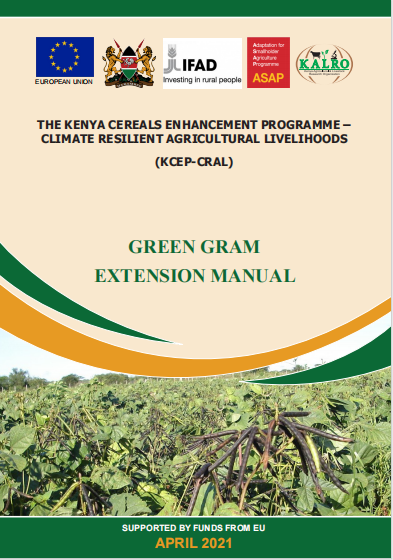 INTRODUCTION
Pulses, or grain legumes in general, are an essential source of supplementary protein. They
provide energy, protein, essential minerals, vitamins and several compounds considered
beneficial for good health. Their cultivation enriches soil by adding nitrogen and improves
the physical, chemical and biological properties. They are also well suited to diverse
environments and fit in various cropping systems owing to their wide adaptability, low
input requirements, fast growth, nitrogen fixing and weed smothering ability. Their short
growing period and photoperiod sensitivity make them suitable for crop intensification
and diversification. Notwithstanding their high production potential, their productivity is
generally low as they are cultivated on poor lands, with no or little inputs, and are susceptible
to several abiotic and biotic stresses.
INTRODUCTION
Pulses, or grain legumes in general, are an essential source of supplementary protein. They
provide energy, protein, essential minerals, vitamins and several compounds considered
beneficial for good health. Their cultivation enriches soil by adding nitrogen and improves
the physical, chemical and biological properties. They are also well suited to diverse
environments and fit in various cropping systems owing to their wide adaptability, low
input requirements, fast growth, nitrogen fixing and weed smothering ability. Their short
growing period and photoperiod sensitivity make them suitable for crop intensification
and diversification. Notwithstanding their high production potential, their productivity is
generally low as they are cultivated on poor lands, with no or little inputs, and are susceptible
to several abiotic and biotic stresses.
Continue reading
MAIZE EXTENSION MANUAL
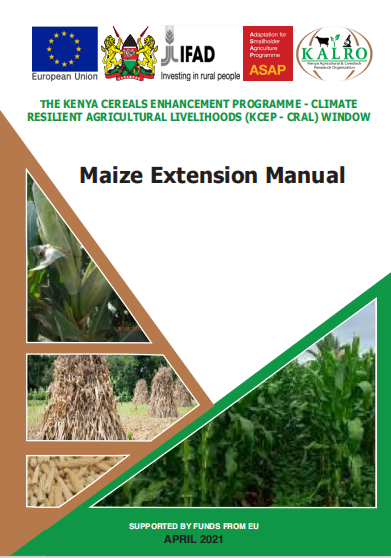 INTRODUCTION/ BACKGROUND
Maize is a staple food in Kenya, accounting for an average production of 4.4 million tons
for the period 2010 to 2013 (FAO, 2015). It contributes to about 65% of daily per capita
cereal consumption and serves as subsistence and a commercial crop grown on an estimated
1.4 million hectares. Maize production accounts for more than 20% of the total agricultural
production and 25% of agricultural employment in the country. It is an important source of
carbohydrate, protein, iron, vitamin B, and minerals. Maize products include baked, roasted
and boiled fresh maize on the cob, porridge, pastes, beer, starch, oil and livestock feed
from by-products of fresh and dry maize grain. This manual outlines important maize-crop
agronomy and provides information on the methodology and technology that farmers may
be able to utilise to grow maize in Kenya sustainably and commercially.
INTRODUCTION/ BACKGROUND
Maize is a staple food in Kenya, accounting for an average production of 4.4 million tons
for the period 2010 to 2013 (FAO, 2015). It contributes to about 65% of daily per capita
cereal consumption and serves as subsistence and a commercial crop grown on an estimated
1.4 million hectares. Maize production accounts for more than 20% of the total agricultural
production and 25% of agricultural employment in the country. It is an important source of
carbohydrate, protein, iron, vitamin B, and minerals. Maize products include baked, roasted
and boiled fresh maize on the cob, porridge, pastes, beer, starch, oil and livestock feed
from by-products of fresh and dry maize grain. This manual outlines important maize-crop
agronomy and provides information on the methodology and technology that farmers may
be able to utilise to grow maize in Kenya sustainably and commercially.
Continue reading
PIGEON PEA EXTENSION MANUAL
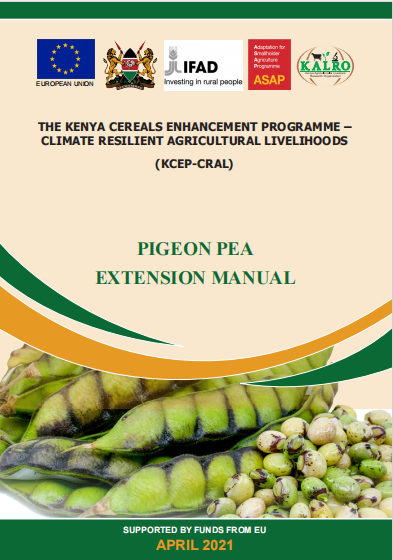 INTRODUCTION
Pulses, or grain legumes in general, are an essential source of supplementary protein to
daily diets based on cereals and starch for those who cannot afford expensive animal
protein. Pulses are therefore often regarded as poor man’s meat”. They also provide energy,
essential minerals, vitamins and several compounds considered beneficial for good health.
Their cultivation enriches soil by adding nitrogen, and improves the physical, chemical and
biological soil properties. They are also well suited to diverse environments and fit in many
cropping systems owing to their wide adaptability, low input requirements, fast growth,
nitrogen fixing and weed smothering ability. Their short growing period and photoperiod
sensitivity make them suitable for crop intensification and diversification.
INTRODUCTION
Pulses, or grain legumes in general, are an essential source of supplementary protein to
daily diets based on cereals and starch for those who cannot afford expensive animal
protein. Pulses are therefore often regarded as poor man’s meat”. They also provide energy,
essential minerals, vitamins and several compounds considered beneficial for good health.
Their cultivation enriches soil by adding nitrogen, and improves the physical, chemical and
biological soil properties. They are also well suited to diverse environments and fit in many
cropping systems owing to their wide adaptability, low input requirements, fast growth,
nitrogen fixing and weed smothering ability. Their short growing period and photoperiod
sensitivity make them suitable for crop intensification and diversification.
Continue reading
INTEGRATED SOIL FERTILITY AND WATER MANAGEMENT EXTENSION MANUAL
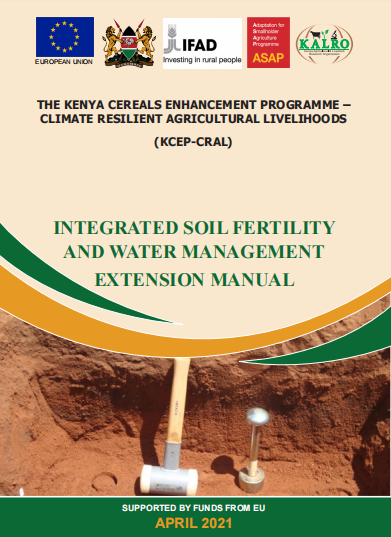 INTRODUCTION
Our food is part of a global chain of production and distribution, which impacts our health,
environment, and economy. Soils are at the base of our food production. It is estimated that
95% of the food for the more than 7 billion people is directly or indirectly produced on
our soils. Food availability is however, unevenly distributed and about one billion people
in developing world are structurally underfed due to social, economic, political factors,
climate change as well as biophysical factors such as land degradation and, land and water
resources competition. Projections indicate that the world’s population will increase by 2
billion in the next 30 years, from 7.7 billion currently to 9.7 billion people in 2050. To meet
this increase food biophysical, socio-economic availability and productive capacity must be
improved. Of crucial in this regard is the capacity of land users worldwide to manage their
soils sustainably and productively.
INTRODUCTION
Our food is part of a global chain of production and distribution, which impacts our health,
environment, and economy. Soils are at the base of our food production. It is estimated that
95% of the food for the more than 7 billion people is directly or indirectly produced on
our soils. Food availability is however, unevenly distributed and about one billion people
in developing world are structurally underfed due to social, economic, political factors,
climate change as well as biophysical factors such as land degradation and, land and water
resources competition. Projections indicate that the world’s population will increase by 2
billion in the next 30 years, from 7.7 billion currently to 9.7 billion people in 2050. To meet
this increase food biophysical, socio-economic availability and productive capacity must be
improved. Of crucial in this regard is the capacity of land users worldwide to manage their
soils sustainably and productively.
Continue reading
NATIONAL AGRICULTURE PRODUCTION REPORT 2023-2024
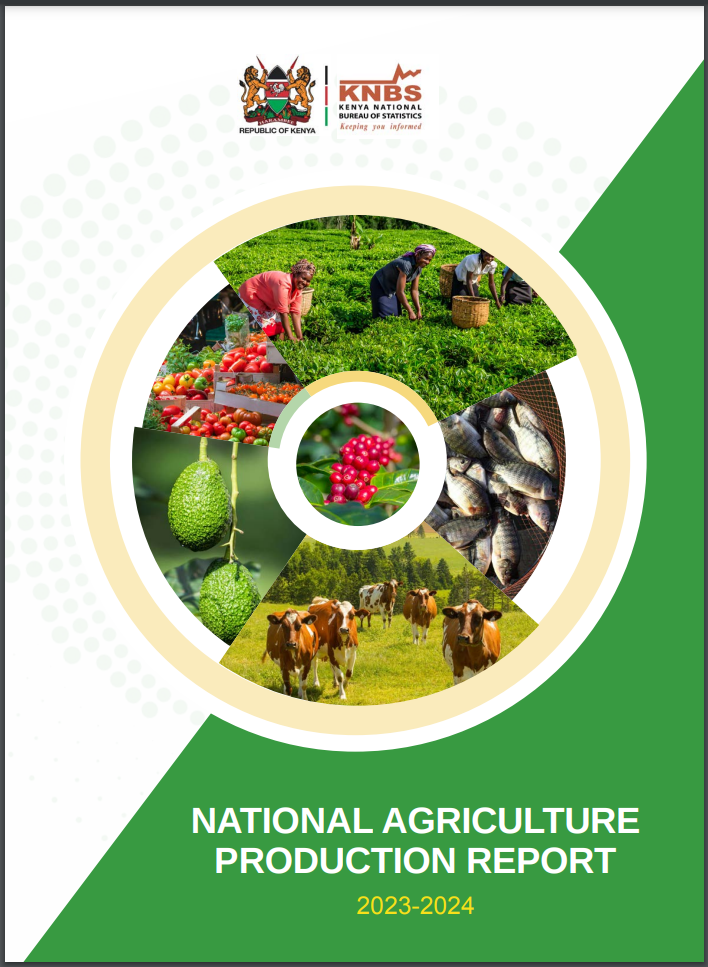 The agricultural sector remains an integral part of Kenya’s economy, accounting for 21.8 per cent of the Gross Domestic Product (GDP) in 2023. Given the key role that the sector plays in the Kenyan economy, it is increasingly important to ensure that high-frequency, quality data is available to inform the food supply situation in the country volumes available to support manufacturing and for export. This data informs the degree of our foreign dependence on food stocks and raw materials to support our industries. Towards this end, the Kenya National Bureau of Statistics, in collaboration with the Ministry of Agriculture and Livestock Development and the Department of Blue Economy, annually carries out a data validation exercise on area under agricultural production, volumes and values of production by agricultural enterprises in all the 47 counties. This is done with a view of establishing how the sector performed based on weather conditions and other interventions in the reporting period.
The agricultural sector remains an integral part of Kenya’s economy, accounting for 21.8 per cent of the Gross Domestic Product (GDP) in 2023. Given the key role that the sector plays in the Kenyan economy, it is increasingly important to ensure that high-frequency, quality data is available to inform the food supply situation in the country volumes available to support manufacturing and for export. This data informs the degree of our foreign dependence on food stocks and raw materials to support our industries. Towards this end, the Kenya National Bureau of Statistics, in collaboration with the Ministry of Agriculture and Livestock Development and the Department of Blue Economy, annually carries out a data validation exercise on area under agricultural production, volumes and values of production by agricultural enterprises in all the 47 counties. This is done with a view of establishing how the sector performed based on weather conditions and other interventions in the reporting period.
Continue reading
